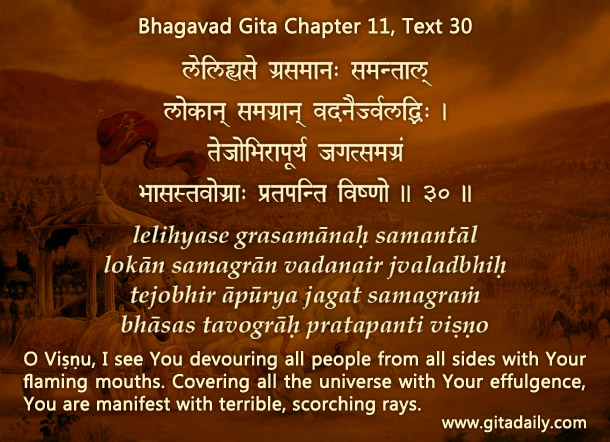The revelation of the universal form is the most dramatic event in the Bhagavad-gita’s narrative. Why is this dramatic revelation present in a philosophical book like the Gita? It serves to illustrate the Gita’s teachings, based on both the immediate context and the broader context.
Immediate context: In the Gita chapters before the chapter on the universal form (namely, chapters nine and ten), Krishna has explained his mysterious relationship with the material world. The most direct assertion of this mystery occurs in chapter nine, where Krishna elaborates on that relationship using twin statements that seem directly contradictory: he sustains the world (09.04) and he doesn’t sustain the world (09.05). Such is his mystical opulence (09.05: yogam-aishvaram). In that chapter and especially in the next chapter, Krishna explains through philosophical analysis and cosmic examples how he sustains everything in existence (10.42). Arjuna requests Krishna to reveal that opulence of his (rupam-aishvarm) and Krishna responds by showing the universal form.
Broader context: In its fourth chapter, the Gita has dramatically expanded the ambit of the concept of yajna (fire-sacrifice), by stating how a wide gamut of human activities can be conducted in a mood of sacrifice. The implication is that Arjuna can see the battle at Kurukshetra as a sacrifice, with those propagating or supporting adharma being the oblation and Arjuna being the priest offering that oblation. As such a sacrificial image might be unusual for Arjuna and he might hesitate to play his part in it, the universal form demonstrates the fulfillment of that sacrifice through its time aspect (kala-rupa). The revelation of the Kaurava warriors entering into the fiery mouth of the universal form demonstrates that this sacrifice is being accepted by the divine. Hence, the concluding call to Arjuna to do his part.
One-sentence summary:
The universal form is revealed to manifest Krishna’s opulence and persuade Arjuna to do his duty in a sacrificial mood.
Think it over:
- Why does Arjuna ask Krishna to display the universal form?
- How does Krishna use Arjuna’s request to further the Gita’s overall purpose?
- How does the universal form illustrate the understanding of the war as a sacrifice?
***
11.30: O Vishnu, I see You devouring all people from all sides with Your flaming mouths. Covering all the universe with Your effulgence, You are manifest with terrible, scorching rays.
To know more about this verse, please click on the image


God is Great